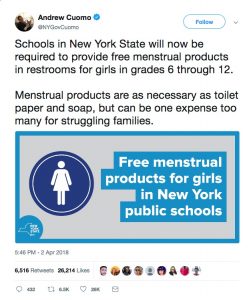Spurred by legislation introduced by New York State Assemblymember Linda Rosenthal, that state adopted a law that requires public schools to provide free menstrual hygiene products for students in grades 6-12.
In April, 2018, Governor Andrew Cuomo tweeted the news: “Schools in New York State will now be required to provide free menstrual products in restrooms for girls in grades 6 through 12. Menstrual products are as necessary as toilet paper and soap, but can be one expense too many for struggling families.”
 Governor Cuomo conveniently left out of his tweet that the mandate is unfunded. In other words, school districts must figure out how to pay for these menstrual hygiene products.
Governor Cuomo conveniently left out of his tweet that the mandate is unfunded. In other words, school districts must figure out how to pay for these menstrual hygiene products.
Earlier this week, the Rochester (New York) Democrat & Chronicle reported (here) on what that has meant, in dollars and cents, for some upstate school districts:
The startup costs for having dispensers in bathrooms are thousands of dollars for local school districts.
The upkeep cost implications won’t be known until the machines are being used by the students, said Gates Chili Superintendent Kimberle Ward.
Districts will need to find the money in their budgets this year to comply, Laural Heiden, a spokesperson for Greece Central School District, explained. Greece has spent $8,700 on the purchase of dispensers alone, Heiden said.
Webster Central School District spent about the same. Webster purchased 24 feminine hygiene product dispensers totaling about $8,800. * * *
The East Rochester Union Free School District has its 12 dispensers ready to go. The project cost about $3,700 in materials and $280 in labor, said David Green, assistant superintendent for finance and operations.
The Honeoye Falls-Lima Central School District is similar to other local schools that worked to get the machines and products installed before the first day of school, according to spokesperson Leah Shepard. Their process started in June and will cost the district about $3,000. * * *
About 42 percent of children in New York live in low-income families, and a monthly supply of feminine hygiene products can be expensive for struggling families.
The need is real. No doubt, this change will help thousands of low-income individuals and families. But to completely analyze the impact of the legal change, it is worthwhile to consider who bears what cost.
Consider the example of Yonkers, a city just outside New York City that I pass through every day on my way to work (and a place with a long history of segregation in housing and education). The Yonkers school district serves 27,000 students and has 39 schools, according to its website (here). According to local news reports (see here, e.g.), the Yonkers Board of Education approved spending $37,474 for the installation of dispensers installed in 175 restrooms. That’s a cost of just over $214 per restroom.
The larger expenditure will be for the products that fill the dispensers. LoHud.com reports (here) that the Yonkers Board of Education estimates that the supplies will cost $125,000 to $200,000 annually, depending on the rate of consumption. Let’s assume that only half (or 13,500) of the 27,000 students in the City of Yonkers are in 6th through 12th grades, and only half of those students (or 6,750) menstruate. That means the school district’s estimated spending, at the high end, is just over $29 per year for each menstruating student.
Is that a good “deal” for the school district, or not?
Consider the cost of a box of pads. To take one example, on Amazon, a box of 88 Always Ultra Thin Long/Super Unscented pads costs $21.93 (or, about 25 cents per pad). Assuming tax and transaction costs out of the equation (be still my tax teacher’s heart!) and the use of 4 pads a day for 7 days every month for 12 months, the annual cost to the retail consumer would be $84. Certainly, there are brands and products that cost less than 25 cents per pad or tampon. Some women may need more or fewer or different products. But just as a ballpark, it looks like the estimate by the Yonkers Board of Education is not unreasonable.
So how much will those “free” tampons cost? About $29 per year per student. Who bears the cost? The taxpayers, as is true with most expenses by the school district.
My guess is that we will begin to see schools seeking to reduce costs by partnering with manufacturers that will agree to a reduced payment from the schools in return for “product placement.” There’s nothing wrong with that. But it’s good to be aware of what I call menstrual capitalism (see here, here, here and here, e.g.). Menstrual capitalism is the complex interaction of the market economy and profit-seeking behavior, on the one hand, and apparent philanthropic, benevolent or even feminist support of menstrual equity efforts, on the other. The two sides of the issue can and do co-exist; I have no critique of that. But often, the philanthropic/benevolent/feminist position may be used to obscure or even deny traditional profit-seeking activity. That is a complex interaction worthy of further examination.

